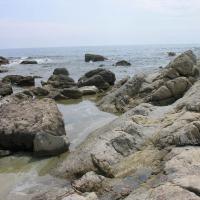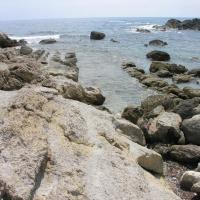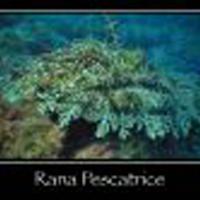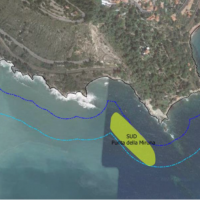Establishment and perimeter
The Marine Protection Area of Capo Mortola is in all respects an integral part of the regional Protected Area "Hanbury Botanical Gardens", the management of which is entrusted to the University of Genoa, as provided for by art. 1, paragraph 2 and art. 3 of the regional law of 27 March 2000 n. 31..
Its perimeter was approved by the Regional Council on 09/28/2018.
The ATM of Capo Mortola has the following objectives:
- protect the stretch of sea facing the Hanbury Botanical Gardens from a biological and geological perspective, promoting the conservation of the species, ecosystems and mineral formations present;
- encourage, promote and develop research activities and the use of the stretch of sea facing the Hanbury Botanical Gardens for scientific, cultural, social, educational and recreational purposes, also taking into account the activities traditionally carried out in the area.
The ATM of Capo Mortola covers the stretch of sea between the Piana di Latte and the Balzi Rossi in the Municipality of Ventimiglia within the following points (Datum WGS 84):
Miraggio a terra -Balzi Rossi 43° 47’ 02,4’’ N 7° 32’ 00,0’’ E
Meda a mare – Vertice di Ponente 43° 46’ 19,1’’ N 7° 32’ 00,0’’ E
Meda a mare – Vertice di Levante 43° 46’ 00.0’’ N 7° 34’ 00,0’’ E
Miraggio a terra -Piana di Latte 43° 47’ 23,7’’ N 7° 34’ 00,0’’ E
Natural features
The Posidonia oceanica meadow
The Protected Area is characterized by the presence of Posidonia oceanica meadows.
The fundamental role played by Posidonia oceanica is due to several factors, including:
- the production of a significant quantity of oxygen essential for the development of biological processes;
- lto the production of biomass and energy which is distributed, through the trophic network, to the grassland fauna and subsequently outside, in other ecosystems, both neighboring and distant and much deeper
- It offers shelter and is a breeding area for many fish, cephalopods, bivalves, gastropods, echinoderms and tunicates, constituting a real reservoir of biodiversity:
- consolidates the seabed near the coast, helping to counteract excessive transport of fine sediments by coastal currents;
- it acts as a barrier by dampening the force of currents and waves, preventing coastal erosion;
The rarefaction and disappearance of Posidonia meadows are due to multiple causes, including:
- the mechanical action of trawling which very often operates, against the law, within the 50 metre bathymetric depth;
- the mechanical action caused by the anchors and their chains of pleasure boats;
- pollution, which can act in various ways (polluting agents, turbidity) and have various causes (discharges, hydrocarbon spills, detergents and paints used in navigation, solid waste, etc.)
- eutrophication of coastal waters which causes abnormal growth of epiphytic algae, thus hindering photosynthesis.
A species protected by EU regulations that has been found mainly in the Posidonia meadow is the large bivalve Pinna nobilis. The latter is the subject of an international repopulation project made necessary by the presence of a protozoan that caused its death, a phenomenon that affected the entire Mediterranean Sea.
The Coralligenous
A second infralittoral habitat is precisely the rocky bottoms covered with macroalgae (coralligenous) that appears on the numerous shoals present in the territory. On the so-called ‘Pertuso’ shoal, one of the most representative of the area, large specimens have been counted in large numbers belonging to species such as the dentex (Dentex dentex), the three white seabreams (Diplodus puntazzo, D. sargus and D. vulgaris) and the dusky grouper (Epinephelus marginatus). In addition to the white seabreams, damselfish, anthias, salema, gilt-head bream, dentex, amberjack, sunfish, conger eels, moray eels, scorpion fish and anglerfish are quite common; rarer are the John Dory (Zeus faber) and the leopard goby (Thorogobius macrolepis).
Large shoals that rise in large numbers, like mountains rich in biodiversity, represent sites of considerable importance for the breeding of commercial species relevant for professional and sport fishing outside the Marine Protection Area and charismatic for underwater tourism.
Noteworthy is the presence of the yellow-mouth barracuda (Sphyraena viridensis), now frequent in many parts of the Mediterranean. It is easy to observe various species of nudibranchs with splendid reflections of every color, including Glossodoris elegans, Hypselodoris tricolor and Umbraculum mediterraneum, anemones (Alicia mirabilis), octopuses, spider crabs, porter crabs (Dromia personata), sea urchins, lobsters. The rocky substrates of the shoals are covered with large sponges, false black corals (Savalia savaglia), fan worms, red gorgonians and expanses of cluster daisies (Parazoanthus axinellae).
Karst springs
On the seabed of Capo Mortola there is also a freshwater karst spring, known as Polla di Rovereto (dedicated to the geologist Gaetano Rovereto) and, locally, as “Funtana sutumarina”, which flows at a depth of 36 m from a crack in an underwater cave. In 2003 this spring, reported among the Geotopes of greatest interest in the Province of Imperia, was harnessed and now flows just below the surface from a metal “hourglass”, with a flow rate of 100 liters per second at a temperature of 10 °C.
Wrecks and archaeological finds
It is also worth mentioning the presence of a Gazelle helicopter wreck, which lies among the gorgonians. Just outside the Marine Protection Area, at a depth of around 53 m, lies the wreck of a yacht that sank due to a fire in the 70s and is colonized by countless jewel anemones (Cornyactis viridis).
Finally, among the values of this stretch of the far west, we can point out underwater archaeological finds dating back to the Roman era and on the shore, west of Capo Mortola, the prehistoric site of Balzi Rossi with an adjoining museum, also founded by Thomas Hanbury.
The exceptional richness of species and biocenosis, also confirmed by the results of the studies and censuses cited, partly available on the REMARE and GBH websites, once again highlights the importance of the stretch of sea in front of the Hanbury Botanical Gardens.
In awareness of these riches, the ATM Regulations provide that the following are prohibited:
- the withdrawal of water, the removal, even partial, and the damage of organisms, geological and mineral formations and paleontological and archaeological finds
- the discharge of polluting substances into the sea, as well as the abandonment of objects, tools, waste of any nature or anything else that may directly or indirectly cause damage to the marine ecosystem.
Regulation
FOR ADMINISTRATIVE ISSUES THE FORMS FOR THE REQUESTS LISTED BELOW WILL BE AVAILABLE IN THE FIRST MONTHS OF 2025.
The Regulations of the Marine Protection Area of Capo Mortola and related implementing provisions, approved on 01.06.2024 by the Management Committee of the regional protected area Giardini Botanici Hanbury and adopted on 12.06.2024 by the managing body GBH&HBG University Service Center – University of Genoa.
The regulations contain these main elements:
Access
Transit prohibited for vessels larger than 24 m, at a distance of less than 500 m from the coast;
Access prohibited throughout the area for jet skis and similar vehicles
Navigation is permitted in exclusive displacement
Moorings
Anchoring is prohibited for vessels with an overall length exceeding 5 meters on a seabed characterized by the presence of Posidonia oceanica meadows; however, these may anchor in areas without Posidonia oceanica meadows, or moor to the regulated mooring buoys set up by the Management Body. The mooring buoys present within the site are of two types: - yellow for vessels up to 15 m maximum LOA; - red for vessels up to 10 m maximum LOA.
The mooring of vessels to support authorized individual scuba diving is permitted in the places indicated on the Management Body's website and periodically updated. In these sites, the method of stopping the vessels will also be indicated, either with autonomous mooring or with a mooring pole, for the time strictly sufficient to carry out the dive.
Fishing
Small-scale professional fishing is possible but is reserved for: fishermen resident in Ventimiglia, fishermen belonging to cooperatives based in the municipality of Ventimiglia, fishing companies with boats registered with the Maritime Offices between Bordighera and Sanremo, subject to authorization from the Management Body. Upon expiration of each fishing authorization, to facilitate monitoring of the fish fauna, the concessionaire is required to provide a report on the catch, indicating type, quantity and size.
Non-professional fishing is permitted subject to authorization from the Management Body, according to specific regulations. Non-professional fishermen can use the following equipment: trolling, bottom fishing, lines and rods, with a maximum of two tools per person and in any case no more than three tools per boat.
Diving
Diving with auxiliary breathing apparatus, both private and through Diving Centers and Diving Clubs, can be carried out from dawn to dusk, subject to authorization by the Management Body
Naval units used for carrying out scuba diving with breathing apparatus must use the mooring structures set up by the Management Body or drop anchor at the anchorage sites specifically identified for this purpose using geographical coordinates by the Management Body
Environmental protection prohibitions
Water withdrawal, removal, even partial, and damage to organisms, geological and mineral formations and paleontological and archaeological finds are prohibited
The discharge of polluting substances into the sea is prohibited, as is the abandonment of objects, tools, waste of any nature or anything else that may directly or indirectly cause damage to the marine ecosystem.
Mooring
The mooring buoys are distributed over three buoy fields, one to the east (Baia di Latte) with 7 buoys (boats up to 10 m) and 7 buoys (boats up to 15 m), one to the south (Punta della Miruna) with 4 (10m) and 4 (15m) buoys, and one to the west (Baia Beniamin) with 4 (10m) and 4 (15m) buoys.
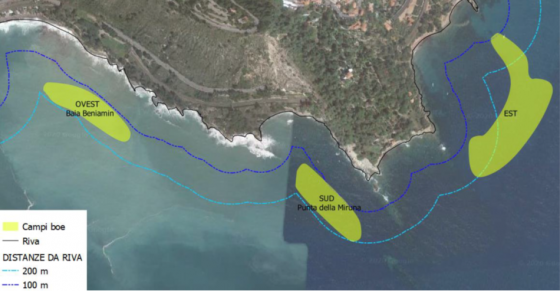

yellow color, truncated conical shape for boats up to 15 m maximum loa;
red color, toroidal shape for boats up to 10 m maximum loa.
Mooring is permitted, for only one boat per buoy, with a maximum stay between half an hour before sunrise and half an hour after sunset. It is not permitted to exceed the established time limits.
All boats that intend to moor must be registered and insured for RC, giving notice to the managing body which reserves the right not to accept boats without the aforementioned requirements.
Mooring Authorizations
Mooring at buoy fields must be booked by the working day before mooring, indicating the following data, via email: gbhsegreteria@unige.it
Date of mooring
Mooring buoy field
Copy of identity documents and tax code of the applicant
photograph of the boat
Civil liability insurance
declaration of having read the ATM regulations and acceptance of the rules above them
receipt of the requested payment.
The managing body checks the availability of the place and issues the authorization if possible
The mooring authorization is valid for one day only.
The cost of the authorization is €25 for administrative fees
Any damage to the moorings, if found within the first 15 minutes of the start of mooring, must be communicated to the Management Body via email: gbhsegreteria@unige.it
Otherwise, the Management Body reserves the right to charge the owner of the vessel that intends to moor the costs of repair
Mooring authorization request form
Payment: PagoPA for Italy - IBAN for payments from abroad
Diving
Within the ATM it is possible to carry out dives with auxiliary breathing apparatus both privately and through diving centers and diving clubs, they can be carried out from dawn to dusk, subject to authorization from the managing body.
The naval units used for carrying out scuba diving with breathing apparatus must use the mooring structures set up by the managing body or drop anchor at the anchorage sites specifically identified for this purpose by means of geographical coordinates by the managing body
Diving Authorizations
Diving can be done either by individuals or by diving/tourism boats to which different rates apply.
Diving must be authorized by the working day before the excursion, indicating the following data, via an email communication: gbhsegreteria@unige.it
Dive date
Dive location
Mooring buoy/independent mooring
Copy of the applicant's identity documents and tax code
Photo of the boat
Civil liability insurance
Number of participants
Declaration of having read the ATM regulations and accepted the rules above them
Receipt of the requested payment
The Management Body verifies the request and issues the authorization
The authorization is valid for a single day, a week, a month or for the entire calendar year.
The cost of the authorization is €20 per day, €70 per week, €100 per month, and €300 per year + €10 for secretarial fees.
The mooring of boats to support authorized individual scuba diving is permitted, where present, at the individual buoys marked and specifically prepared by the Management Body, positioned compatibly with the need to protect the seabed, for the time strictly sufficient to carry out the dive.
Any damage to the mooring buoy, if found within the first 15 minutes of mooring, must be reported to the Management Body via email: gbhsegreteria@unige.it
Otherwise, the Management Body reserves the right to charge the owner of the vessel that intends to moor for the costs of repair
Where not present, the locations of the authorized sites for scuba diving with breathing apparatus are indicated by the Management Body and periodically updated
Suggested places as of 01.08.2024
Dive site | LAT N | LONG E | Docking mode |
Monaco NORD | 43° 46,372' | 007° 33,634' |
|
Monaco SUD (Testa del Monaco) | 43° 46,314' | 007° 33,670' | autonomous |
Desolation | 43° 46,542' | 007° 32,581' | alla panna |
Pertuso | 43° 46,592' | 007° 32,335' |
|
San Giuseppe (Riccio) | 43° 46,611' | 007° 32,660' |
|
Aragostine (Elicottero) | 43° 46 400' | 007° 33,377' |
|
Fontana N | 43° 46,676' | 007° 32,494' |
|
Pignatun | 43° 46,210' | 007° 33,711 |
|
Diving authorization request form
Payment: PagoPA for Italy - IBAN for payments from abroad
Fishing
Within the ATM:
it is possible to carry out small-scale professional fishing but it is reserved for: fishermen resident in Ventimiglia, fishermen belonging to cooperatives based in the municipality of Ventimiglia, fishing companies with boats registered with the Maritime Offices between Bordighera and Sanremo, subject to authorization from the Management Body. Upon expiration of each fishing authorization, to facilitate monitoring of the fish fauna, the concessionaire is required to provide a report on the catch, indicating type, quantity and size
non-professional sport fishing is permitted both from land and from boats, subject to authorization from the Management Body, according to specific regulations. Non-professional fishermen can use the following equipment: trolling, bottom fishing, lines and rods, with a maximum of two tools per person and in any case no more than three tools per boat
Fishing Permits
Sport and professional fishing must be authorised.
The authorisation for sport fishing, both from land and from a boat, can be daily or weekly and must be requested within the working day before the start of the activities, indicating the following data, by sending an email to: gbhsegreteria@unige.it
application form
copy of the identity documents and tax code of the applicant
photograph of the boat
type of equipment used
declaration of having read the ATM regulations and acceptance of the rules above them
receipt of the requested payment.
The cost of the authorization is €10 per day and €20 per week + €10 administrative fees
The managing body verifies the characteristics of the request and issues, if possible, the authorization.
The authorization can be valid for one day or one week.
The professional fishing authorization is monthly or annual and must be requested by the working day before the start of the activities, indicating the following data, via email: gbhsegreteria@unige.it
application form
copy of the identity documents and tax code of the applicant
photograph of the boat
type of equipment used
declaration of having read the ATM regulations and acceptance of the rules overriding them
receipt of the requested payment
The cost of the authorization is €30 monthly and €50 annually + €10 administrative fees
The managing body verifies the characteristics of the request and issues, if possible, the authorization.
In the event of renewal, the application must be accompanied by the summary sheet of the catch made in the previous calendar year.
Fishing authorization request form
Caught in the previous year form
Payment: PagoPA for Italy - IBAN for payments from abroad
Contacts
Ente gestore
Area Protetta Regionale Giardini Botanici Hanbury Corso Montecarlo 43
18039 Ventimiglia (IM)
tel. (+39) 0184 226624
fax (+39) 0184 226632
Presidente: Prof. Luigi Minuto


